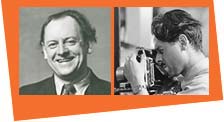Home (The Foundation) - Artist biographies - Ernst Schwitters
Page 1 |
2 | 3 | 4
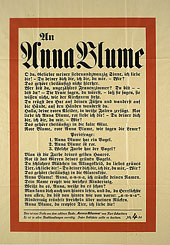 1920
1920
Publication of Die Kathedrale. 8 Lithos von Kurt Schwitters as part of series Die Silbergäule (nos. 41/42), Paul Steegemann Verlag, Hanover, and of Sturm Bilderbücher IV Kurt Schwitters, Sturm Verlag, Berlin.
Produces first i-Zeichnungen (i-drawings).
Meets Michel Seuphor in Cologne and George Grosz in Berlin.
Paul Ferdinand Schmidt purchases The Merzpicture, 1919, for the Dresden Stadtmuseum (for sum of 1,400 reichsmarks).
Christof Spengemann’s monograph Die Wahrheit über Anna Blume, Kritik der Kunst, Kritik der Kritik, Kritik der Zeit appears in Der Zweemann-Verlag, Hanover.
February/March 1920
First exhibition of Merzbilder in Schwitters’s home town of Hanover (included in the third exhibition of the Hanover Secession at the Kestner-Gesellschaft).
April 1920
Visits Max Ernst in Cologne; return visit of Max Ernst in Hanover in second half of that year.
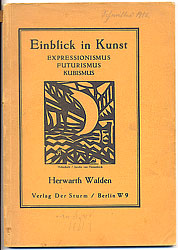 May 1920
May 1920
First public recitals in the Sturm gallery (5 and 11 May; first recital together with Rudolf Blümner, second with Herwarth Walden).
May-July 1920
Several stays in Berlin, visits the Dada fair staged by the Berlin Dadaists in the Kunsthandlung Dr. Otto Buchard.
August 1920
Trip to Dresden. Joint exhibition at the Galerie Arnold with Oskar Schlemmer and Willi Baumeister.
September 1920
Visits Oegenbostel (Lüneburg Heath). Regularly visits Oegenbostel until 1923 as guest of Marie Heckter, a friend from his youth. Produces landscape paintings.
November/December 1920
First inclusion in a show by the Société Anonyme, New York (founded in New York in 1920 by Katherine S. Dreier, Marcel Duchamp and Man Ray); contributes again in 1921, 1926, 1928, 1930, 1936 and 1940; represented in an exhibition of the collection of the Société Anonyme in New Haven in 1942.
1920/21
During frequent visits to Worpswede, establishes contact with the group of young artists surrounding Bernhard Hoetger.
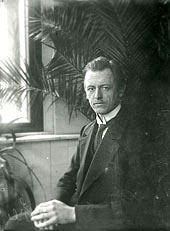 1921
1921
Contributes the lithograph Composition with Left-side Profile of Head to the third portfolio in the series Neue Europäische Graphik by Bauhaus Weimar.
Friendship with the couple Robert Michel and Ella Bergmann-Michel, who are both artists and live in a converted smelting mill near Eppstein in the Taunus region north of Frankfurt-on-Main.
January 1921
Publication of the programmatic essay Merz (written in December 1920) and several reproductions of Merzbilder in the periodical Der Ararat (no. 1), edited by Hans Goltz. Publication in the periodical MA (“Heute”), edited by Lajos Kassák (vol. 6, no. 3), of the essay The Merz Stage, the poem An Anna Blume (translated into Hungarian by Kahána Mózes), and Merzbilder reproductions.
First inclusion in an exhibition at the Galerie von Garvens in Hanover (inlaid boxes made to Schwitters’s own designs); exhibits at the same gallery again in July 1921 and October/November 1922.
March 1921
Involved in producing the periodical Die Quirlsanze, edited by Rudolf Blümner and appearing on the occasion of the "Sturm ball".
April 1921
First solo show at the Sturm gallery in Berlin (“96. Ausstellung. Kurt Schwitters. Merzbilder, Merzzeichnungen. Gesamtschau” [“96th Exhibition. Kurt Schwitters. Merz Pictures, Merz Drawings. Survey”]).
End of June 1921
Travels to Dresden, Erfurt, Weimar and Leipzig for recitals and lectures.
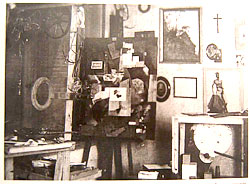 July 1921
July 1921
First publication of poems and texts in the periodical De Stijl. International maandblad voor nieuwe kunst, wetenschap en kultuur (vol. 4, no. 7), edited by Theo van Doesburg.
Reading in Jena (Rosensaal), organized by Jena Kunstverein, whose director is Walter Dexel (4 July).
September 1921
Anti-Dada-Merz-Trip to Prague with Raoul Hausmann, Hannah Höch and Helma Schwitters (a literary evening is staged in the Saal Urania on 6 September).
1922
Produces first sound poems.
New edition of Anna Blume. Dichtungen, Paul Steegemann Verlag, Hanover. Publication of book of poems Elementar. Die Blume Anna. Die neue Anna Blume. Eine Gedichtsammlung aus den Jahren 1918-1922, Sturm Verlag, Berlin, and Memoiren Anna Blume in Bleie. Eine leichtfaßliche Methode zur Erlernung des Wahnsinns für Jedermann, Verlag Walter Heinrich, Freiburg i. Br.
March/April 1922
Solo show in the Roemer-Museum, Hildesheim, where he delivers a lecture on “Developments in Modern Painting” (9 April).
May 1922
The i-Manifesto is published in the periodical Der Sturm (vol. 13, no. 5).
September 1922
Visits brother-in-law Friedrich Fischer in Vrestorf (near Lüneburg). Produces landscapes.
Stay in Weimar and Jena. Visits Walter Dexel in Jena along with Theo and Nelly van Doesburg, Hans Arp and Tristan Tzara (23-27 September). Dada recital evenings in Jena Kunstverein (23-24 September). Takes part in “International Congress of Constructivists and Dadaists” in Weimar. Meets Sándor Bortnyik.
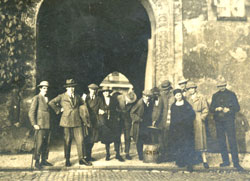 Dada
soirée (Dadarevon) in Galerie von Garvens, Hanover, together with Hans
Arp, Nelly and Theo van Doesburg, and Tristan Tzara (29-30 September).
Dada
soirée (Dadarevon) in Galerie von Garvens, Hanover, together with Hans
Arp, Nelly and Theo van Doesburg, and Tristan Tzara (29-30 September).
October 1922
Trip to Berlin on invitation of El Lissitzky (15 October). Visits “First Russian Exhibition” at the Galerie van Diemen, Berlin.
November/December 1922
Represented for first time in an exhibition of the Dutch artists’ group De Branding in Rotterdam and The Hague; participates in other exhibitions in Rotterdam and Utrecht (1923-24) and in Amsterdam and Rotterdam in winter 1925-26.
Winter 1922-23
Shares studio with László Moholy-Nagy in Spichernstrasse, Berlin.
Solo shows at Graphisches Kabinett Georg Maulhardt and Kunstsalon Maria Kunde, Hamburg.
1922-1926
Intensive preoccupation with the art of International Constructivism.
1923
Probable start of work on the Merzbau (Merz building) in Hanover. Produces first reliefs.
Publication of Auguste Bolte (ein Lebertran). Tran Nr. 30, Sturm Verlag, Berlin.
January-April 1923
Journey to the Netherlands (5 January-13 April). Dada-Tour with Theo and Nelly van Doesburg and Vilmos Huszár.
The first issue of Schwitters’s periodical Merz is published under the title Merz 1. Holland Dada.
April 1923
Exhibition and recital evening at the Galerie Linné und Ziegert, Bremen.
Publication of Merz 2. nummer i.
Between April and June 1923
Publication of Merz 3. Kurt Schwitters 6 Lithos auf den Stein gemerzt.
June 1923
Stay in Dresden. Solo exhibition at the Galerie Emil Richter, Dresden.
July 1923
Publication of Merz 4. Banalitäten.
August 1923
Summer holiday in the Villa Garund in Sellin on island of Rügen (together with his family, Hans Arp, Sophie Taeuber-Arp and Hannah Höch). Collaboration with Hans Arp (production of text Franz Müller’s Wire Springtime) and Hannah Höch.
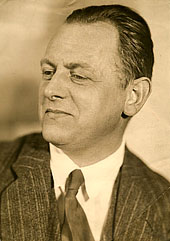 Summer 1923
Summer 1923
Publication of Merz 5. 7 Arpaden (portfolio with 7 lithographs by Hans Arp).
October 1923
Publication of Merz 6. Imitatoren watch step. Arp 1 Prapoganda und Arp.
23 November 1923
Merz evening in the Deutsches Haus, Braunschweig
30 December 1923
Large Merz matinée staged jointly with Raoul Hausmann in Konzerthaus Tivoli, Hanover. El Lissitzky designs the poster publicising the event.
1924
Publication of Merz 11. Typoreklame = Pelikan-Nummer and Der Hahne Peter (Familie Hahnepeter Nr. 1), illustrated by Käte Steinitz, in 50 signed, hand-coloured copies, by the publishing house Apossverlag, which Kurt Schwitters co-established with Käte Steinitz (as Aposs 1; simultaneously as Merz 12), as well as publication of Die Märchen vom Paradies, illustrated by Käte Steinitz, Aposs Verlag (Aposs 2; 1925 as Merz 16/17).
Contributions to the following periodicals: Der Sturm, edited by Herwarth Walden; G. Zeitschrift für elementare Gestaltung, edited by Hans Richter; Pásmo moderní leták, edited in Prague by group Devětsil; BLOK. Revue internationale d’Avantgarde, edited in Warsaw by Henryk Stazéwski, Teresa Žarnowerówna, Mieczysław Szeczuka and Edmund Miller; Het overzicht, edited in Antwerp by Michel Seuphor.
Founding of Merz-Werbezentrale (Merz advertising office); increasing volume of work as typographer in the following years.
Meets Friedrich Vordemberge-Gildewart and Hans Nitzschke in Hanover.
January 1924
Publication of MERZ 7. Tapsheft
February/March 1924
Numerous Merz evenings at, among other places, Atelier Dungert, Hanover (3 February), Kunstgewerbeschule, Magdeburg (5 February), Jena (13 February) and Feurich Halle, Leipzig (4 March).
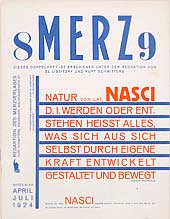 Between
April and July 1924
Between
April and July 1924
Publication of Merz 8/9. Nasci in collaboration with El Lissitzky.
July 1924
Stay on island of Rügen.
September 1924
Represented with Normalbühne< Merz/em> at the “International Exhibition on New Theatre Technology” in Vienna. Excerpt from Aus der Welt: Merz. Ein Dialog mit Einwürfen aus dem Publikum reprinted in catalogue; exhibition subsequently travels to Paris and New York.
October 1924
Joint exhibition with Hans Arp and Alexej Jawlensky in the Kestner-Gesellschaft, Hanover.
1925
Release of Merz 13 Merz-Grammophonplatte with private recording of the scherzo from the Ursonate.
Publication of Die Scheuche, Märchen in collaboration with Käte Steinitz and Theo van Doesburg, Apossverlag, Hanover (simultaneously appears as Merz 14/15).
Ludwig Hilberseimer’s Grossstadtbauten published by Apossverlag, Hanover, as the first number in the Neue Architektur series (appears in 1926 as Merz 18/19). Due to cost considerations, the scheduled further publications in the series do not appear.
Contributes to Elementare Typographie issue of the Typographischen Mitteilungen, edited by Jan Tschichold.
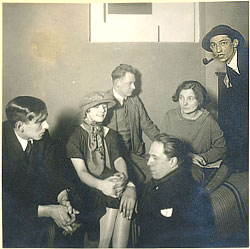 29
January 1925
29
January 1925
Fairy-tale reading at the Bauhaus in Weimar.
14 February 1925
Joint recital evening with Nelly van Doesburg (piano) in Potsdam at the house of Frau Kiepenheuer - first performance of the Ursonate.
March 1925
Stay in Hellerau near Dresden (6 March). Readings in Dresden. Meets Margit von Plato and the collector Ida Bienert.
July 1925
Stay in Göhren on island of Rügen. Works on the manuscript of Normalbühne Merz.
Summer 1925
Travels to the Netherlands with Helma Schwitters. Visits the Hungarian painter Maler Lajos d’Ebneth in Kijkduin near Scheveningen.
September 1925
Becomes subscriptions agent in Germany for the journal De Stijl.
April 1926
Katherine S. Dreier visits Hanover (23 April) in order to prepare the “International Exhibition of Modern Art” to be held as of November in the Brooklyn Museum, New York, organized by the Société Anonyme. She accompanies Schwitters to his recital at the Bauhaus in Dessau (28 April).
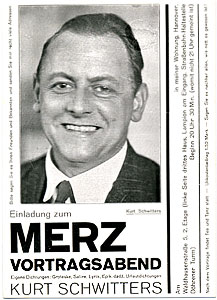 May 1926
May 1926
Reciteal in Kunstsalon Fides, Dresden (14 May), and two “grotesque evenings” in Prague on invitation of the group Devětsil (20-21 May).
May/June 1926
Week-long tour of the Netherlands with Katherine S. Dreier. Visit to Lajos d’Ebneth in Kijkduin near Scheveningen, where Kurt Schwitters also paints. Possible meeting with the Swiss art theorists Sigfried Giedion and Carola Giedion-Welcker.
Summer 1926
Cruise on the Rhine to Bad Neuenahr with his parents and Helma Schwitters.
September/October 1926
Due to a typhoid epidemic in Hanover, spends six weeks on farm of brother-in-law Friedrich Fischer in Retelsdorf near Schönberg (Mecklenburg-Strelitz); works on manuscript of Merzbuch 1 Die Kunst der Gegenwart ist die Zukunft der Kunst, which was announced as a Bauhaus book but never appeared.
October/November 1926
Four-week visit to Berlin and Dresden. Excursion to the Ore Mountains with Ida Bienert.
December 1926
Takes part in official opening of the Bauhaus in Dessau (recital on 5 December). Subsequently stays in Dresden, holds recital and stays with Ida Bienert in Zwickau, travels on to Halle and Eibenstock.
December 1926/January 1927
Solo show in Bohemian Kunstverein, Prague.
1927
Solo exhibition “Grosse Merzausstellung 1927” begins; extensive itinerary (including Wiesbaden, Frankfurt-on-Main, Bochum, Barmen and Cologne). Publication of Merz 20. Kurt Schwitters. Katalog. to accompany the show.
Translation into musical notation of the Ursonate begins (lasting until 1940).
February 1927
Numerous Merz evenings staged in, among other places, the house of Dr. Ackermann in Hanover (2 February), the Prinzessinnenschlösschen in Jena (13 February), in Schwitters’s house at Waldhausenstrasse in Hanover (15 February) and in Rudolf Jahns’s studio in Holzminden (24 February).
12 March 1927
Co-founds the group “die abstrakten hannover” (officially a sub-group of the Berlin artists’ group “Die Abstrakten. Internationale Vereinigung der Expressionistem, Futuristen, Kubisten und Konstruktivisten e. V.”) with Carl Buchheister, Rudolf Jahns, Hans Nitzschke and Friedrich Vordemberge-Gildewart. César Domela joins later, the only non-Hanover member. Numerous joint exhibitions in the years that follow.
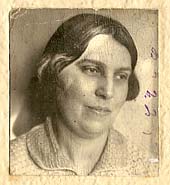 April 1927
April 1927
Collaboration with Käte Steinitz on a libretto for the grotesque opera Der Zusammenstoß, for which they win second prize (300 reichsmarks) at a competition in Vienna in August 1928.
Four-week trip to France an Belgium.
May 1927
Travels to Prague for the premiere of his play Schattenspiel (written around 1925) in an avant-garde theatre in Prague (8 May).
Contributes typographical work to an exhibition “Neue Reklame” (“New Advertising”) at the Jena Kunstverein.
June 1927
Poem An Anna Blume published in the American literary journal Transition (no.3), edited by Eugene Jonas (translation as Eve Blossom by Myrtle Klein).
June/July 1927
Visits Robert Michel and Ella Bergmann-Michel in the Schmelzmühle. First meeting regarding the foundation of the association of new advertising artists “ring neue werbegestalter” with Robert Michel, Willi Baumeister, Jan Tschichold, Walter Dexel, Friedrich Vordemberge-Gildewart, César Domela and László Moholy-Nagy.
August/September 1927
Anregungen zur Erlangung einer Systemschrift published in the periodical i 10 (vol. 1, nos. 8/9).
Tours the Netherlands together with Robert Michel and Ella Bergmann-Michel (19-23 September), visits Hannah Höch in The Hague.
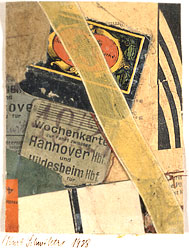 December 1927/January 1928
December 1927/January 1928
Represented in the Ausstellung "Neue Typographie“ (“New Typography”) exhibition in the Gewerbemuseum, Basel.
Commissioned to design festschrift of “Cinnabar Festival” in the Hannoversches Konzerthaus, Hanover, organised by Hanover branch of the Reichsverband Bildender Künstler (7 January). Writes the song Zinnoberschlager in collaboration with the composer Walter Gieseking.
Spring 1928
Five-week excursion to Italy (Rome, Naples, Sicily) as a guest student of the art historical institute of the Technical High School, Hanover.
Summer (?) 1928
Stays for several weeks with Lajos d’Ebneth in Kijkduin near Scheveningen.
28 November 1928
Recital of sound poems by Katherine S. Dreier and I. Weisshaus at an evening staged in the house of the president of the Société Anonyme, New York.
8 December 1928
“Festival of Technology” in Hanover, staged by the association of Hanover engineering and science societies. Jointly commissioned with Käte Steinitz to design the festival revue and programme brochure; music by Walter Gieseking.
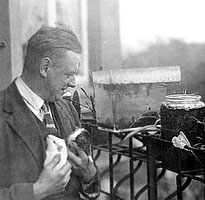 1929
1929
Signs contract as typographer with the Hanover town administration (until 1934). Increasing lecture activities as typographer (lecture on “Design in Typography”).
Becomes member of artists’ association Cercle et Carré, France; other members include Le Corbusier, Piet Mondrian, Wassily Kandinsky.
January/February 1929
Stay with Til Brugmann and Hannah Höch in The Hague.
May/July 1929
Represented in exhibition “Film und Foto. Internationale Ausstellung des deutschen Werkbundes” in Stuttgart.
July 1929
First journey to Scandinavia, together with Helma Schwitters (to Spitzbergen via Norway).
Herbst 1929
Designs all the exhibition publications for the Dammerstock housing project, Karlsruhe, led by Walter Gropius.
October/November 1929
Represented in the exhibition “Abstrakte und Surrealistische Malerei und Plastik” (“Abstract and Surrealist Painting and Sculpture”) at the Zurich Kunsthaus. Joint recital with Hans Arp during a soirée organized for the exhibition (30 October).
Included in an exhibition of contemporary photography in Essen; other venues are Hanover, Berlin, Dresden and Magdeburg.
1929-1932
Annual trips to Paris.
Page 1 | 2 | 3 | 4
© Kurt und Ernst Schwitters Stiftung
 1920
1920Publication of Die Kathedrale. 8 Lithos von Kurt Schwitters as part of series Die Silbergäule (nos. 41/42), Paul Steegemann Verlag, Hanover, and of Sturm Bilderbücher IV Kurt Schwitters, Sturm Verlag, Berlin.
Produces first i-Zeichnungen (i-drawings).
Meets Michel Seuphor in Cologne and George Grosz in Berlin.
Paul Ferdinand Schmidt purchases The Merzpicture, 1919, for the Dresden Stadtmuseum (for sum of 1,400 reichsmarks).
Christof Spengemann’s monograph Die Wahrheit über Anna Blume, Kritik der Kunst, Kritik der Kritik, Kritik der Zeit appears in Der Zweemann-Verlag, Hanover.
February/March 1920
First exhibition of Merzbilder in Schwitters’s home town of Hanover (included in the third exhibition of the Hanover Secession at the Kestner-Gesellschaft).
April 1920
Visits Max Ernst in Cologne; return visit of Max Ernst in Hanover in second half of that year.
 May 1920
May 1920 First public recitals in the Sturm gallery (5 and 11 May; first recital together with Rudolf Blümner, second with Herwarth Walden).
May-July 1920
Several stays in Berlin, visits the Dada fair staged by the Berlin Dadaists in the Kunsthandlung Dr. Otto Buchard.
August 1920
Trip to Dresden. Joint exhibition at the Galerie Arnold with Oskar Schlemmer and Willi Baumeister.
September 1920
Visits Oegenbostel (Lüneburg Heath). Regularly visits Oegenbostel until 1923 as guest of Marie Heckter, a friend from his youth. Produces landscape paintings.
November/December 1920
First inclusion in a show by the Société Anonyme, New York (founded in New York in 1920 by Katherine S. Dreier, Marcel Duchamp and Man Ray); contributes again in 1921, 1926, 1928, 1930, 1936 and 1940; represented in an exhibition of the collection of the Société Anonyme in New Haven in 1942.
1920/21
During frequent visits to Worpswede, establishes contact with the group of young artists surrounding Bernhard Hoetger.
 1921
1921 Contributes the lithograph Composition with Left-side Profile of Head to the third portfolio in the series Neue Europäische Graphik by Bauhaus Weimar.
Friendship with the couple Robert Michel and Ella Bergmann-Michel, who are both artists and live in a converted smelting mill near Eppstein in the Taunus region north of Frankfurt-on-Main.
January 1921
Publication of the programmatic essay Merz (written in December 1920) and several reproductions of Merzbilder in the periodical Der Ararat (no. 1), edited by Hans Goltz. Publication in the periodical MA (“Heute”), edited by Lajos Kassák (vol. 6, no. 3), of the essay The Merz Stage, the poem An Anna Blume (translated into Hungarian by Kahána Mózes), and Merzbilder reproductions.
First inclusion in an exhibition at the Galerie von Garvens in Hanover (inlaid boxes made to Schwitters’s own designs); exhibits at the same gallery again in July 1921 and October/November 1922.
March 1921
Involved in producing the periodical Die Quirlsanze, edited by Rudolf Blümner and appearing on the occasion of the "Sturm ball".
April 1921
First solo show at the Sturm gallery in Berlin (“96. Ausstellung. Kurt Schwitters. Merzbilder, Merzzeichnungen. Gesamtschau” [“96th Exhibition. Kurt Schwitters. Merz Pictures, Merz Drawings. Survey”]).
End of June 1921
Travels to Dresden, Erfurt, Weimar and Leipzig for recitals and lectures.
 July 1921
July 1921First publication of poems and texts in the periodical De Stijl. International maandblad voor nieuwe kunst, wetenschap en kultuur (vol. 4, no. 7), edited by Theo van Doesburg.
Reading in Jena (Rosensaal), organized by Jena Kunstverein, whose director is Walter Dexel (4 July).
September 1921
Anti-Dada-Merz-Trip to Prague with Raoul Hausmann, Hannah Höch and Helma Schwitters (a literary evening is staged in the Saal Urania on 6 September).
1922
Produces first sound poems.
New edition of Anna Blume. Dichtungen, Paul Steegemann Verlag, Hanover. Publication of book of poems Elementar. Die Blume Anna. Die neue Anna Blume. Eine Gedichtsammlung aus den Jahren 1918-1922, Sturm Verlag, Berlin, and Memoiren Anna Blume in Bleie. Eine leichtfaßliche Methode zur Erlernung des Wahnsinns für Jedermann, Verlag Walter Heinrich, Freiburg i. Br.
March/April 1922
Solo show in the Roemer-Museum, Hildesheim, where he delivers a lecture on “Developments in Modern Painting” (9 April).
May 1922
The i-Manifesto is published in the periodical Der Sturm (vol. 13, no. 5).
September 1922
Visits brother-in-law Friedrich Fischer in Vrestorf (near Lüneburg). Produces landscapes.
Stay in Weimar and Jena. Visits Walter Dexel in Jena along with Theo and Nelly van Doesburg, Hans Arp and Tristan Tzara (23-27 September). Dada recital evenings in Jena Kunstverein (23-24 September). Takes part in “International Congress of Constructivists and Dadaists” in Weimar. Meets Sándor Bortnyik.
 Dada
soirée (Dadarevon) in Galerie von Garvens, Hanover, together with Hans
Arp, Nelly and Theo van Doesburg, and Tristan Tzara (29-30 September).
Dada
soirée (Dadarevon) in Galerie von Garvens, Hanover, together with Hans
Arp, Nelly and Theo van Doesburg, and Tristan Tzara (29-30 September).
October 1922
Trip to Berlin on invitation of El Lissitzky (15 October). Visits “First Russian Exhibition” at the Galerie van Diemen, Berlin.
November/December 1922
Represented for first time in an exhibition of the Dutch artists’ group De Branding in Rotterdam and The Hague; participates in other exhibitions in Rotterdam and Utrecht (1923-24) and in Amsterdam and Rotterdam in winter 1925-26.
Winter 1922-23
Shares studio with László Moholy-Nagy in Spichernstrasse, Berlin.
Solo shows at Graphisches Kabinett Georg Maulhardt and Kunstsalon Maria Kunde, Hamburg.
1922-1926
Intensive preoccupation with the art of International Constructivism.
1923
Probable start of work on the Merzbau (Merz building) in Hanover. Produces first reliefs.
Publication of Auguste Bolte (ein Lebertran). Tran Nr. 30, Sturm Verlag, Berlin.
January-April 1923
Journey to the Netherlands (5 January-13 April). Dada-Tour with Theo and Nelly van Doesburg and Vilmos Huszár.
The first issue of Schwitters’s periodical Merz is published under the title Merz 1. Holland Dada.
April 1923
Exhibition and recital evening at the Galerie Linné und Ziegert, Bremen.
Publication of Merz 2. nummer i.
Between April and June 1923
Publication of Merz 3. Kurt Schwitters 6 Lithos auf den Stein gemerzt.
June 1923
Stay in Dresden. Solo exhibition at the Galerie Emil Richter, Dresden.
July 1923
Publication of Merz 4. Banalitäten.
August 1923
Summer holiday in the Villa Garund in Sellin on island of Rügen (together with his family, Hans Arp, Sophie Taeuber-Arp and Hannah Höch). Collaboration with Hans Arp (production of text Franz Müller’s Wire Springtime) and Hannah Höch.
 Summer 1923
Summer 1923Publication of Merz 5. 7 Arpaden (portfolio with 7 lithographs by Hans Arp).
October 1923
Publication of Merz 6. Imitatoren watch step. Arp 1 Prapoganda und Arp.
23 November 1923
Merz evening in the Deutsches Haus, Braunschweig
30 December 1923
Large Merz matinée staged jointly with Raoul Hausmann in Konzerthaus Tivoli, Hanover. El Lissitzky designs the poster publicising the event.
1924
Publication of Merz 11. Typoreklame = Pelikan-Nummer and Der Hahne Peter (Familie Hahnepeter Nr. 1), illustrated by Käte Steinitz, in 50 signed, hand-coloured copies, by the publishing house Apossverlag, which Kurt Schwitters co-established with Käte Steinitz (as Aposs 1; simultaneously as Merz 12), as well as publication of Die Märchen vom Paradies, illustrated by Käte Steinitz, Aposs Verlag (Aposs 2; 1925 as Merz 16/17).
Contributions to the following periodicals: Der Sturm, edited by Herwarth Walden; G. Zeitschrift für elementare Gestaltung, edited by Hans Richter; Pásmo moderní leták, edited in Prague by group Devětsil; BLOK. Revue internationale d’Avantgarde, edited in Warsaw by Henryk Stazéwski, Teresa Žarnowerówna, Mieczysław Szeczuka and Edmund Miller; Het overzicht, edited in Antwerp by Michel Seuphor.
Founding of Merz-Werbezentrale (Merz advertising office); increasing volume of work as typographer in the following years.
Meets Friedrich Vordemberge-Gildewart and Hans Nitzschke in Hanover.
January 1924
Publication of MERZ 7. Tapsheft
February/March 1924
Numerous Merz evenings at, among other places, Atelier Dungert, Hanover (3 February), Kunstgewerbeschule, Magdeburg (5 February), Jena (13 February) and Feurich Halle, Leipzig (4 March).
 Between
April and July 1924
Between
April and July 1924 Publication of Merz 8/9. Nasci in collaboration with El Lissitzky.
July 1924
Stay on island of Rügen.
September 1924
Represented with Normalbühne< Merz/em> at the “International Exhibition on New Theatre Technology” in Vienna. Excerpt from Aus der Welt: Merz. Ein Dialog mit Einwürfen aus dem Publikum reprinted in catalogue; exhibition subsequently travels to Paris and New York.
October 1924
Joint exhibition with Hans Arp and Alexej Jawlensky in the Kestner-Gesellschaft, Hanover.
1925
Release of Merz 13 Merz-Grammophonplatte with private recording of the scherzo from the Ursonate.
Publication of Die Scheuche, Märchen in collaboration with Käte Steinitz and Theo van Doesburg, Apossverlag, Hanover (simultaneously appears as Merz 14/15).
Ludwig Hilberseimer’s Grossstadtbauten published by Apossverlag, Hanover, as the first number in the Neue Architektur series (appears in 1926 as Merz 18/19). Due to cost considerations, the scheduled further publications in the series do not appear.
Contributes to Elementare Typographie issue of the Typographischen Mitteilungen, edited by Jan Tschichold.
 29
January 1925
29
January 1925 Fairy-tale reading at the Bauhaus in Weimar.
14 February 1925
Joint recital evening with Nelly van Doesburg (piano) in Potsdam at the house of Frau Kiepenheuer - first performance of the Ursonate.
March 1925
Stay in Hellerau near Dresden (6 March). Readings in Dresden. Meets Margit von Plato and the collector Ida Bienert.
July 1925
Stay in Göhren on island of Rügen. Works on the manuscript of Normalbühne Merz.
Summer 1925
Travels to the Netherlands with Helma Schwitters. Visits the Hungarian painter Maler Lajos d’Ebneth in Kijkduin near Scheveningen.
September 1925
Becomes subscriptions agent in Germany for the journal De Stijl.
April 1926
Katherine S. Dreier visits Hanover (23 April) in order to prepare the “International Exhibition of Modern Art” to be held as of November in the Brooklyn Museum, New York, organized by the Société Anonyme. She accompanies Schwitters to his recital at the Bauhaus in Dessau (28 April).
 May 1926
May 1926 Reciteal in Kunstsalon Fides, Dresden (14 May), and two “grotesque evenings” in Prague on invitation of the group Devětsil (20-21 May).
May/June 1926
Week-long tour of the Netherlands with Katherine S. Dreier. Visit to Lajos d’Ebneth in Kijkduin near Scheveningen, where Kurt Schwitters also paints. Possible meeting with the Swiss art theorists Sigfried Giedion and Carola Giedion-Welcker.
Summer 1926
Cruise on the Rhine to Bad Neuenahr with his parents and Helma Schwitters.
September/October 1926
Due to a typhoid epidemic in Hanover, spends six weeks on farm of brother-in-law Friedrich Fischer in Retelsdorf near Schönberg (Mecklenburg-Strelitz); works on manuscript of Merzbuch 1 Die Kunst der Gegenwart ist die Zukunft der Kunst, which was announced as a Bauhaus book but never appeared.
October/November 1926
Four-week visit to Berlin and Dresden. Excursion to the Ore Mountains with Ida Bienert.
December 1926
Takes part in official opening of the Bauhaus in Dessau (recital on 5 December). Subsequently stays in Dresden, holds recital and stays with Ida Bienert in Zwickau, travels on to Halle and Eibenstock.
December 1926/January 1927
Solo show in Bohemian Kunstverein, Prague.
1927
Solo exhibition “Grosse Merzausstellung 1927” begins; extensive itinerary (including Wiesbaden, Frankfurt-on-Main, Bochum, Barmen and Cologne). Publication of Merz 20. Kurt Schwitters. Katalog. to accompany the show.
Translation into musical notation of the Ursonate begins (lasting until 1940).
February 1927
Numerous Merz evenings staged in, among other places, the house of Dr. Ackermann in Hanover (2 February), the Prinzessinnenschlösschen in Jena (13 February), in Schwitters’s house at Waldhausenstrasse in Hanover (15 February) and in Rudolf Jahns’s studio in Holzminden (24 February).
12 March 1927
Co-founds the group “die abstrakten hannover” (officially a sub-group of the Berlin artists’ group “Die Abstrakten. Internationale Vereinigung der Expressionistem, Futuristen, Kubisten und Konstruktivisten e. V.”) with Carl Buchheister, Rudolf Jahns, Hans Nitzschke and Friedrich Vordemberge-Gildewart. César Domela joins later, the only non-Hanover member. Numerous joint exhibitions in the years that follow.
 April 1927
April 1927 Collaboration with Käte Steinitz on a libretto for the grotesque opera Der Zusammenstoß, for which they win second prize (300 reichsmarks) at a competition in Vienna in August 1928.
Four-week trip to France an Belgium.
May 1927
Travels to Prague for the premiere of his play Schattenspiel (written around 1925) in an avant-garde theatre in Prague (8 May).
Contributes typographical work to an exhibition “Neue Reklame” (“New Advertising”) at the Jena Kunstverein.
June 1927
Poem An Anna Blume published in the American literary journal Transition (no.3), edited by Eugene Jonas (translation as Eve Blossom by Myrtle Klein).
June/July 1927
Visits Robert Michel and Ella Bergmann-Michel in the Schmelzmühle. First meeting regarding the foundation of the association of new advertising artists “ring neue werbegestalter” with Robert Michel, Willi Baumeister, Jan Tschichold, Walter Dexel, Friedrich Vordemberge-Gildewart, César Domela and László Moholy-Nagy.
August/September 1927
Anregungen zur Erlangung einer Systemschrift published in the periodical i 10 (vol. 1, nos. 8/9).
Tours the Netherlands together with Robert Michel and Ella Bergmann-Michel (19-23 September), visits Hannah Höch in The Hague.
 December 1927/January 1928
December 1927/January 1928 Represented in the Ausstellung "Neue Typographie“ (“New Typography”) exhibition in the Gewerbemuseum, Basel.
Commissioned to design festschrift of “Cinnabar Festival” in the Hannoversches Konzerthaus, Hanover, organised by Hanover branch of the Reichsverband Bildender Künstler (7 January). Writes the song Zinnoberschlager in collaboration with the composer Walter Gieseking.
Spring 1928
Five-week excursion to Italy (Rome, Naples, Sicily) as a guest student of the art historical institute of the Technical High School, Hanover.
Summer (?) 1928
Stays for several weeks with Lajos d’Ebneth in Kijkduin near Scheveningen.
28 November 1928
Recital of sound poems by Katherine S. Dreier and I. Weisshaus at an evening staged in the house of the president of the Société Anonyme, New York.
8 December 1928
“Festival of Technology” in Hanover, staged by the association of Hanover engineering and science societies. Jointly commissioned with Käte Steinitz to design the festival revue and programme brochure; music by Walter Gieseking.
 1929
1929Signs contract as typographer with the Hanover town administration (until 1934). Increasing lecture activities as typographer (lecture on “Design in Typography”).
Becomes member of artists’ association Cercle et Carré, France; other members include Le Corbusier, Piet Mondrian, Wassily Kandinsky.
January/February 1929
Stay with Til Brugmann and Hannah Höch in The Hague.
May/July 1929
Represented in exhibition “Film und Foto. Internationale Ausstellung des deutschen Werkbundes” in Stuttgart.
July 1929
First journey to Scandinavia, together with Helma Schwitters (to Spitzbergen via Norway).
Herbst 1929
Designs all the exhibition publications for the Dammerstock housing project, Karlsruhe, led by Walter Gropius.
October/November 1929
Represented in the exhibition “Abstrakte und Surrealistische Malerei und Plastik” (“Abstract and Surrealist Painting and Sculpture”) at the Zurich Kunsthaus. Joint recital with Hans Arp during a soirée organized for the exhibition (30 October).
Included in an exhibition of contemporary photography in Essen; other venues are Hanover, Berlin, Dresden and Magdeburg.
1929-1932
Annual trips to Paris.
Page 1 | 2 | 3 | 4
© Kurt und Ernst Schwitters Stiftung

